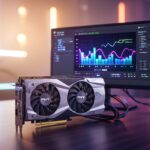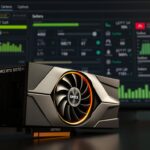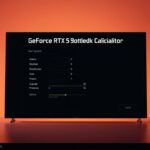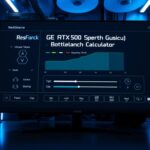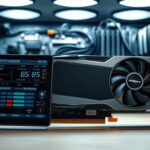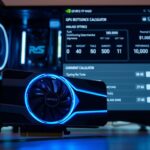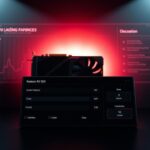Last Updated on August 28, 2025 by Gill
Curious which CPU will hold back your new GPU purchase, or if your setup already wastes money?
This short guide shows how to use a simple bottleneck tool to match a modern graphics card to a CPU and RAM so you get smooth frame pacing without overspending.
Launched June 4, 2025 at $349, the card is built on Navi 44 (RDNA 4.0) with 2048 shaders, 128 TMUs, 64 ROPs and 16gb gddr6 on a 128-bit bus at 20.1 Gbps. It tops out near 3130 MHz boost, draws 160 W, and offers HDMI 2.1b plus two DisplayPort 2.1a outputs on a PCIe 5.0 x16 slot.
In plain terms, the calculator helps you see where performance limits appear so you can plan a balanced purchase. Follow the quick workflow here and you’ll know when memory capacity, clock rates, or output choices affect perceived smoothness in games and creator apps.
Key Takeaways
- Use the calculator to spot whether your CPU, RAM, or video card limits performance.
- The card’s 16gb gddr6 and 3130 MHz boost influence frame pacing at high resolutions.
- At $349 launch price, balance price and performance for a smarter purchase.
- Display outputs and PCIe 5.0 can affect latency and perceived smoothness.
- Follow the step-by-step workflow to tune settings and reduce wasted headroom.
What a GPU bottleneck is and why it matters for the RX 9060 XT
Understanding when your GPU is the limiting factor helps you pick upgrades that actually raise frame rates.
GPU, processor, and memory must work together. A graphics card can sit idle if the CPU can’t prepare draw calls fast enough. The reverse is also true: a weak GPU limits how much the processor and memory improvements can deliver.
The RX 9060 XT’s amd rdna design pushes high boost clocks (up to 3130 MHz) and 322.3 GB/s of bandwidth. That power often exposes a slow processor or sluggish DDR5 memory at 1080p in fast esports titles.
At higher resolutions, the graphics workload grows and the GPU usually becomes the limiter. Knowing this switch helps you target the right upgrade and save on overall price.
How RDNA 4 features change the balance
Hardware ray tracing and variable-rate shading move pressure onto different parts of the system. Ray tracing taxes the GPU’s RT cores, while VRS can ease load and improve frame pacing.
- If CPU-bound, lowering CPU-heavy settings helps little.
- If GPU-bound, turning down resolution or ray tracing yields quick gains.
- Use the calculator to quantify which component limits your gaming performance and avoid wasted upgrades.
System facts you need before using the calculator
Start by listing your CPU, memory, motherboard, and display so the model reflects your system.
Gather CPU, RAM, motherboard, and display details
Processor model: Note the exact chip (example: amd ryzen 7800x3d or 9800X3D), its boost behavior, and whether your BIOS is up to date. This affects single-thread bursts and sustained game loops.
Memory: Record DDR5 speed and timings — 6000–8000 MT/s kits change CPU-limited results at 1080p and 1440p. Also list total memory so the tool models frame buffering correctly.
Motherboard and lanes: Confirm the PCIe slot runs at full pcie 5.0 x16 bandwidth for the graphics card and note any lane sharing that could reduce throughput.
Display and connection: Capture resolution and refresh rate, and whether you use hdmi 2.1 or dp 2.1. High-refresh 1440p and 4K panels shift where the gpu and processor balance matters.
Quick GPU specs to enter
- Card: amd radeon 9060 series, listed as a graphics card 16gb / card 16gb gddr6 variant.
- Memory: 16gb gddr6 on a 128-bit bus at 20.1 Gbps (≈322.3 GB/s).
- Clocks: base 1700 MHz, game 2530 MHz, boost up to 3130 MHz (enter mhz values precisely).
- Power and connector: 160 W TDP and 1x 8‑pin; verify PSU headroom to avoid throttling.
Extras to note: If you plan to buy an edition graphics card like asus prime radeon or tuf gaming, record cooling type, dual ball fan features, and any BIOS switch. These details affect thermals, acoustics, and real-world performance.
Finally, track current price trends to time your purchase — listed prices can vary from launch offers.
Radeon RX 9060 XT 16 GB Bottleneck Calculator: step-by-step
Follow a short checklist to get an accurate performance readout for your rig.
Start by selecting your exact CPU model and entering DDR5 speed and timings. Accurate memory mhz values matter for 1080p and esports scenarios.
Then pick the video card entry and confirm pcie 5.0 x16 and the 16 GB VRAM setting so bandwidth and capacity are modeled correctly.

Select CPU, memory speed, GPU and resolution
- Choose the exact amd ryzen or other processor so single-thread burst behavior is considered.
- Input DDR5 mhz and timings so the tool estimates CPU throughput accurately.
- Pick 1080p, 1440p, or 4K based on your monitor and target frame rate.
Set game presets and frame-rate targets
Enter typical presets (Medium, High, Ultra) and note if ray tracing or FSR will be used. This makes the model reflect real gaming loads.
Read the percentage and interpret results
The output shows a percentage indicating which component limits performance. A higher CPU percent at 1080p means CPU-limited; a higher GPU percent points to GPU-limited.
- If CPU-limited, tune CPU and memory before a new graphics card purchase.
- If GPU-limited, lowering resolution or settings yields fast gains.
- Use the boost clock (up to 3130 mhz) and VRAM numbers to sanity-check heavy texture or streaming scenarios.
Tip: Save profiles per resolution and re-run after driver, BIOS, or setting changes to confirm the real impact before any purchase decision.
Interpreting results using real-world data
Real-world benches help you turn percentage outputs into practical tuning steps for daily gaming and streaming.
Treat the card’s 100% baseline as your reference point. If your calculator readout diverges significantly, double-check inputs like DDR5 speed, game preset, and resolution.
Pre-launch Geekbench showed OpenCL ~109,315 and Vulkan ~124,251 on an amd ryzen 7 9800X3D system with DDR5-8000. Those numbers place the card roughly 25–31% ahead of the 7600 XT and about 12–14% behind the 7700 XT.
- Expect close raster performance to GeForce RTX 5060/5060 Ti; ray tracing varies by engine.
- A 20–30% gap versus radeon 9070 means 4K Ultra with heavy RT will hit the GPU limit earlier.
- If your result shows CPU limits at 1440p, re-check CPU class and memory timing against the bench system.
| Metric | Relative | Notes |
|---|---|---|
| Baseline | 100% | Use for all comparisons |
| Geekbench OpenCL | 109,315 | Proxy for compute, not FPS |
| Geekbench Vulkan | 124,251 | Closer tie to modern APIs |
| Typical Market Price | $389.99 | “Most Popular GPU” listing |
Optimize CPU pairing to reduce bottlenecks
Choose a processor that feeds the card so you see real gains in frame rates and smoothness.
Best-fit CPUs for the RX 9060 XT
Top picks and budget options
For high-refresh 1080p and 1440p play, pair the card with latency-optimized chips like the amd ryzen 7800x3d or the 9800X3D. These CPUs keep draw-call latency low and raise minimums in fast shooters.
Budget builders can choose Ryzen 5 or Ryzen 7 non-3D models and focus on mild overclocking and memory tuning. That approach improves real-world performance without inflating the purchase price.
BIOS and Windows tweaks
Enable PBO in BIOS and apply a cautious Curve Optimizer negative offset if stable. Update your motherboard firmware first; AGESA updates often fix boost and memory behavior.
In Windows, pick Balanced or High Performance power plans and install the latest chipset driver to help the scheduler. If your calculator shows CPU limits, raise DDR5 frequency and tighten timings before swapping the graphics card or chasing a geforce rtx alternative.
- Re-run the tool after each change to confirm the shift toward GPU-limited results.
- Watch bundle and price moves—sometimes a CPU platform upgrade gives more value than an immediate card swap.
Dial in GPU-specific settings for higher throughput
Fine-tuning GPU settings can unlock steady clocks and higher average frame rates without spending on new hardware.
Start with per-game AMD Software profiles: enable frame generation where it helps, turn on Anti-Lag for low input latency, and test FSR modes to trade clarity for extra frames. Use a profile per title so changes only apply where they matter.
Power, temps, and clocks
Set a gentle custom fan curve to keep the card in its optimal thermal window. Stable temps let boost clocks stay higher and improve sustained performance.
Check the 1x 8-pin connector and PSU headroom; transient power drops cause clock sag that hurts real-world results.
- Try the performance BIOS on partner cards with dual bios to raise power limits, then monitor temps and noise.
- For TUF Gaming or ASUS Prime variants, confirm cooler design, fan bearings, and heatsink mass for longer sustained clocks.
- Use quality HDMI 2.1 or DP 2.1 cables and avoid risers; PCIe 5.0 x16 provides bandwidth, but physical contact and a GPU guard matter.
- After each tweak—power limit, fan curve, or FSR change—re-run your testing to confirm the shift toward balanced performance before any purchase decision.
Memory, storage, and display choices that affect bottlenecks
Small upgrades outside the GPU often deliver the biggest smoothness gains for real-world gaming.
DDR5 speed and timings matter most at 1080p and 1440p. Faster memory reduces latency for draw-call handling and thread scheduling on an amd ryzen platform. If your system feels CPU-limited in esports titles, a tuned DDR5 kit can raise minimums and cut stutter without a new video card purchase.
Games that stream large textures depend on storage. NVMe SSDs load levels and stream assets far smoother than SATA drives. That reduces hitching that can look like a GPU issue during heavy scene changes.
Display and bus considerations
Use high-quality HDMI 2.1 or DP 2.1 cables so your monitor runs at the intended resolution and refresh. The card’s PCIe 5.0 x16 interface removes bus limits, so memory and storage are the usual culprits when you see stutter in streaming-heavy games.
| Component | Action | Expected effect |
|---|---|---|
| DDR5 memory | Increase frequency / tighten timings | Better 1080p/1440p responsiveness; fewer CPU limits |
| Storage | NVMe over SATA | Smoother level streaming; reduced asset pop-in |
| Display cabling | Use certified HDMI 2.1 / DP 2.1 | Full resolution & refresh; avoids forced lower modes |
Practical tip: If your calculator flags CPU limits, prioritize a memory kit or NVMe upgrade before swapping the graphics card. That often yields the best price-to-performance return for 9060 gaming builds.
Board-partner nuances: ASUS TUF, Prime, Sapphire, XFX, and others
Partner cards change how a launch design performs in your system.
Partner boards vary in cooler mass, PCB power, and length. ASUS Prime and TUF Gaming models tune power limits differently, which affects sustained boost and noise. Sapphire’s NITRO+ runs higher boost (about 3320 MHz) and uses a triple-slot cooler with ~182 W board power for extra headroom.
What that means: OC editions from XFX, ASRock, and Sapphire may hit 3320 MHz on paper. But if your CPU is the limiter, higher boost only shifts GPU-bound scenarios by a few percent.
Cooling, slot designs and BIOS choices
Look for dual ball fan bearings and sturdy heatsinks for long sessions. Dual BIOS gives a quiet or performance profile to pick from. Slot footprints vary from dual to 2.5 and triple-slot—measure case clearance and plan airflow or add a gpu guard for long cards.
Out-of-box clocks and purchase trade-offs
Higher factory MHz can raise peak frame rates, but compare the price premium to actual gains. If you consider a geforce rtx 5070, weigh acoustics, size, and feature set—not just raw FPS.
“Choose the board that matches your case, monitor layout, and budget for the best real-world performance.”
| Model | Boost (MHz) | Slots | Board Power |
|---|---|---|---|
| ASUS Prime | 3311 | 2.5 | ~170 W |
| ASUS TUF Gaming | 3130 | 2 | ~160 W |
| Sapphire NITRO+ | 3320 | 3 | ~182 W |
| XFX / ASRock OC | Up to 3320 | 2.5 | ~175 W |
Validate, retest, and iterate your setup

Record frametime graphs alongside FPS to spot microstutters that averages hide. Run three consistent loops at 1080p, 1440p, and 4K and log average FPS and 1% lows for each run.
After any change — driver, BIOS switch, fan curve, or memory tweak — re-run the tests and the tool to confirm direction of change. If spikes match GPU clock drops, check thermals, fan bearings, and airflow. If spikes persist with high CPU use, try memory tuning on your amd ryzen system.
Benchmark workflow
- Use the same benchmark run or save file for each resolution.
- Compare frametime graphs to identify whether the gpu or CPU causes stutter.
- Test dual bios modes on partner cards to find the best balance of acoustics and stability.
| Check | Action | Why it matters |
|---|---|---|
| PCIe slot & seating | Reseat card; use a gpu guard | Prevents intermittent drops on pcie 5.0 links |
| Cables | Confirm HDMI 2.1 / DP 2.1 bandwidth | Ensures correct refresh and video modes |
| Cooling | Verify dual ball fan health; adjust curve | Maintains sustained boost and steady performance |
| Mechanical fit | Check 2.5 slot design clearance | Protects airflow and long-term stability |
Keep a short change log with price and time invested. That record helps decide if a further purchase makes sense for your 9060 gaming goals.
Conclusion
This closing checklist helps you turn test data into a confident purchase that avoids wasted upgrades. Use the tool’s output to match your display, CPU, and RAM so the new graphics card actually improves play. Keep price and measured performance in view when you decide.
Compare alternatives like a GeForce RTX option, including the GeForce RTX 5070, to see whether a different card or a platform tweak gives better value. Check partner features — TUF Gaming coolers, Prime Radeon designs, dual bios, and quality fan bearings — before you buy.
Finally, protect your investment: seat the video card firmly, fit a GPU guard if needed, keep good airflow, and re-test after updates. Small tweaks often beat an early purchase, so let data guide each step.
FAQ
What exactly is a GPU bottleneck and why does it matter for the Radeon RX 9060 XT 16 GB?
How do I know whether the CPU, GPU, or memory is causing the slowdown?
How do RDNA features like ray tracing and VRS change where bottlenecks occur?
What system details should I gather before using a bottleneck tool?
Which GPU specs for the card should I enter into the calculator?
What steps should I follow when using the bottleneck calculator?
How should I interpret a “CPU-limited” result versus “GPU-limited”?
How does this card compare to similar models like GeForce RTX 5060 or RX 7700 XT in real-world tests?
Which CPUs pair best to minimize bottlenecks with this GPU?
What BIOS and Windows tweaks help reduce CPU-side limits?
What GPU-side settings can increase throughput without major heat or power penalties?
How important are power, temps, and connector headroom for stable performance?
Does DDR5 memory speed really affect bottlenecks at 1080p or 1440p?
Will NVMe vs. SATA storage change gaming bottlenecks?
How do board partners like ASUS TUF or Prime affect real-world performance?
Do factory overclocked editions significantly change bottleneck outcomes?
What’s the best benchmark workflow to validate bottleneck changes?
After I change hardware or settings, how often should I retest with the calculator?
- NVIDIA RTX 6000 Ada Generation 48 GB Bottleneck Calculation - October 17, 2025
- Optimize Your GeForce RTX 5070 Performance with Our Bottleneck Tool - October 2, 2025
- GeForce RTX 5090 Bottleneck Calculator: Optimize Your Setup - October 1, 2025


